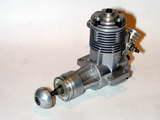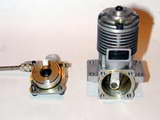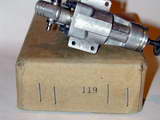|
|
A recent article by Curt Stevens, in the May-June 2004 SAM SPEAKS, gives some interesting commentary on Ivor F. (Stowe) during Mr. Stevens visit to Australia. A lifelong friend and compatriot in the model engine business of Gordon Burford's, he collaborated with Gordon on a number of projects over the years.
The "Sesqui Project" started in 1980-81 by Ivor F. resulted in a unique 1.5 cid diesel of very limited production. Two versions were put out, the MkI and MKII with little difference between them with the MKI designated as the "collector's special". At the time in 1982-83 when the production was on going at Ivor's home in Doonside, Australia it was the only engine being made there. Gordon Burford was the designer, who, for most of three decades manufactured Australia's only volume produced engines, the last being the Taipan ranges. The costs of manufacturing the magnificent Taipan 40 R/C bankrupted the Burford Company in 1975 after some 1,500 of the engines had been turned out. This total project was an early RJL purchase for his stable of out of production engines and brought to California.
The Sesqui was a diesel of uncommonly sophisticated design for such a small motor. It had a displacement of 1.5cc (.09 cid) hence the name Sesqui, which in Latin means one and one half. The engine in marked contrast to most motors of less than 1.5 cid has such features as twin ball bearings, Schnuerle scavenging, a rear rotary drum valve and rear exhaust. It is built around an intricate but sturdy investment casting comprising the crankcase, front bearing housing and finned cylinder casing. The counterbalanced crankshaft supported in steel-caged shielded ball bearing journals, front and rear, has a 7mm diagonal main journal, a 5mm front journal and a 4mm pressed in crankpin.
The lapped cast iron piston is permanently assembled to a hefty conrod by means of a pressed-in wristpin, and the cylinder liner is very thick. The Schnuerle-plus-third-port scavenging system features side bypass ports that are angled slightly upward as well as away from the exhaust. The single third port is inclined sharply upward in the customary manner.
A flat piston head is used in conjunction with a flat contra piston. The cylinder assembly, including a machined aluminum head is tied to the case with four hex socket head cap screws. Instead of having an integral lever, the compression adjustment screw has a headless setscrew for use with a hex key.
This beautiful little engines first "batch" of 100 for collectors was almost an overnight sellout at $55 and the additional production of MKIIs went very fast. It is a most desired collectors engine commanding four and five times the original price and Ivor. F. said no more were to be made. (Incidentally Sesqui means one and one half).
 |
 |
 |
 |
 Back to Model Engine News Home
Back to Model Engine News Home
Back to Janson Index Please submit all questions and comments to [email protected]